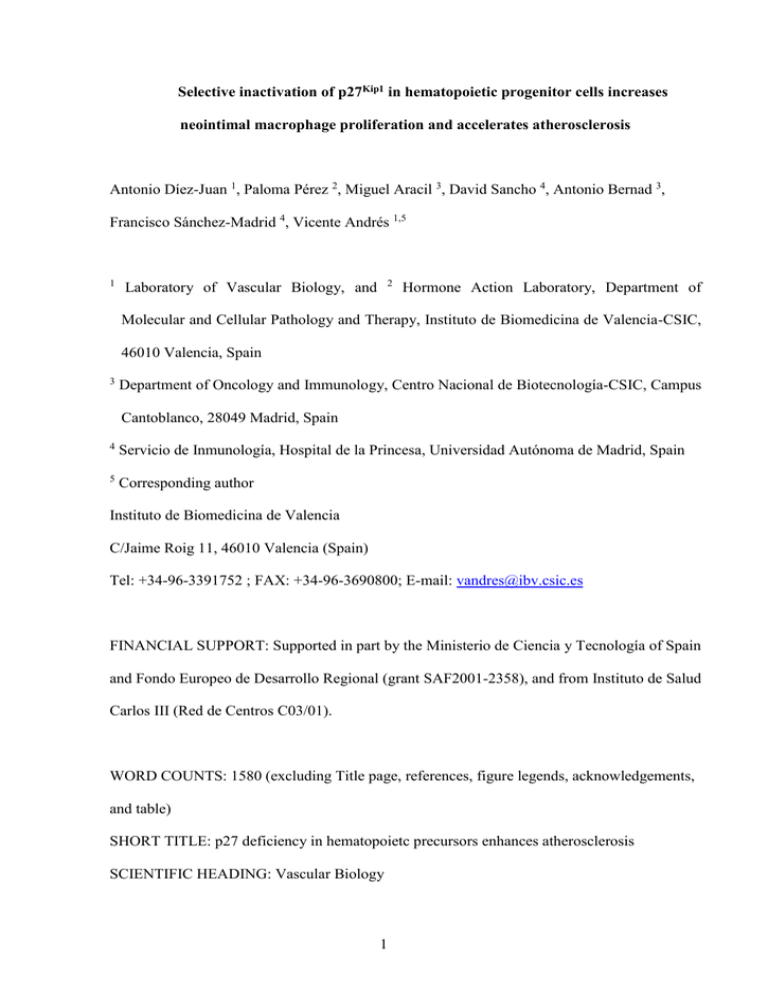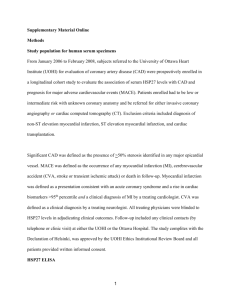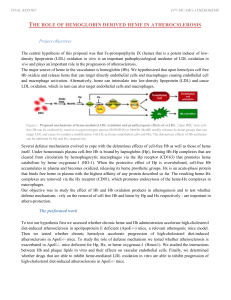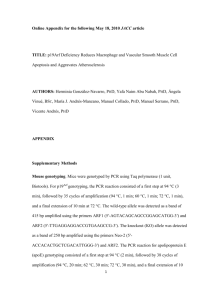Blood 103158-161 (2004).doc
advertisement

Selective inactivation of p27Kip1 in hematopoietic progenitor cells increases neointimal macrophage proliferation and accelerates atherosclerosis Antonio Díez-Juan 1, Paloma Pérez 2, Miguel Aracil 3, David Sancho 4, Antonio Bernad 3, Francisco Sánchez-Madrid 4, Vicente Andrés 1,5 1 2 Laboratory of Vascular Biology, and Hormone Action Laboratory, Department of Molecular and Cellular Pathology and Therapy, Instituto de Biomedicina de Valencia-CSIC, 46010 Valencia, Spain 3 Department of Oncology and Immunology, Centro Nacional de Biotecnología-CSIC, Campus Cantoblanco, 28049 Madrid, Spain 4 Servicio de Inmunología, Hospital de la Princesa, Universidad Autónoma de Madrid, Spain 5 Corresponding author Instituto de Biomedicina de Valencia C/Jaime Roig 11, 46010 Valencia (Spain) Tel: +34-96-3391752 ; FAX: +34-96-3690800; E-mail: vandres@ibv.csic.es FINANCIAL SUPPORT: Supported in part by the Ministerio de Ciencia y Tecnología of Spain and Fondo Europeo de Desarrollo Regional (grant SAF2001-2358), and from Instituto de Salud Carlos III (Red de Centros C03/01). WORD COUNTS: 1580 (excluding Title page, references, figure legends, acknowledgements, and table) SHORT TITLE: p27 deficiency in hematopoietc precursors enhances atherosclerosis SCIENTIFIC HEADING: Vascular Biology 1 Abstract Excessive proliferation of immune cells and vascular smooth myocytes (VSMCs) contribute to atherosclerosis. We have previously shown that whole-body inactivation of the growth suppressor p27 exacerbates atherosclerosis in apolipoprotein E-null mice (apoE-/-), and this correlated with increased proliferation of arterial macrophages and VSMCs. In the present study, we postulated that targeted disruption of bone marrow (BM) p27 is sufficient to enhance arterial macrophage proliferation and atherosclerosis. To test this hypothesis, sublethally irradiated apoE-/- mice with an intact p27 gene were transplanted with BM from either apoE-/or p27-/-apoE-/- doubly deficient donor mice and challenged with a high-cholesterol diet. Compared with mice transplanted with apoE-/- BM, reconstitution with p27-/-apoE-/- doubly deficient marrow increased the expression of proliferating cell nuclear antigen in neointimal macrophages and accelerated aortic atherosclerosis, and this correlated with augmented aortic expression of the inflammatory cytokines CCL2/MCP-1 and CCL5/RANTES. Overall, these findings provide evidence that p27 deficiency in hematopoietic progenitor cells enhances the inflammatory/proliferative response induced by dietary cholesterol and accelerates atherosclerosis. 2 INTRODUCTION Atherosclerotic plaque development is due in part to the recruitment of circulating blood leukocytes into the artery wall, the migration of VSMCs from the media toward the growing neointimal lesion, and hyperplastic cell growth 1,2 . The growth suppressor p27 coordinately inhibits cell proliferation and migration 3. Notably, p27 expression inversely correlates with macrophage and VSMC proliferation within human atherosclerotic tissue 4, and TGF- present in human atherosclerotic tissue may mediate its growth suppressive activity through p27 5. Furthermore, doubly deficient p27-/-apoE-/- mice display accelerated atherogenesis as compared with apoE-/- mice with an intact p27 gene 6. This effect of p27 inactivation was dose-dependent and correlated with augmented proliferation of arterial macrophages and VSMCs. In the present study, we used a BM transplantation model to examine whether targeted inactivation of p27 in hematopoietic precursors is sufficient to increase arterial macrophage proliferation and exacerbate atherosclerosis development. 3 METHODS BM transplantation. Female apoE-/- mice (C57BL/6J, Taconic M&B, Ry, Denmark) irradiated with 2 doses of 5.1 Gy spaced 4 hours apart received transplants of 2x106 BM cells obtained from the pooled femur of 2 male apoE-/- or doubly deficient p27-/-apoE-/- mice (C57BL/6J) 6. After 4 weeks on a standard diet (2.8% fat, Panlab, Barcelona, Spain), transplanted mice were fed for 2 months an atherogenic diet (15.8% fat, 1.25% cholesterol, 0.5% sodium cholate, S4892-S010, Ssniff, Soest, Germany). Plasma cholesterol level was determined as described 6. Quantification of transplantation efficiency, atherosclerosis, and cytokine expression. Fat-fed mice were euthanized and genomic DNA was isolated from BM, spleen and thymus to quantify transplantation efficiency by PCR amplification of a 184-bp fragment of the Y chromosome-specific Zfy-1 gene. DNA amount was normalized by quantitative amplification of a 190-bp fragment of the ras gene. Genomic DNA (20 ng) was amplified in a LightCycler (Roche, Mannheim, Germany) using the SYBR Green I reaction mix (Roche). Serially diluted standard samples of male and female DNA were simultaneously amplified using the same reaction mixture. To quantify cytokine mRNA expression by real-time PCR, 2 g of DNaseI-treated total RNA obtained from snap-frozen aortic arch tissue (Ultraspec RNA isolation system, Biotecx, Houston, Texas, US) was reverse transcribed with MuLV reverse transcriptase (Roche). Primer sequences and amplification programs are available upon request. Detection of fluorescent product was carried out at the last step of each cycle. Aortic atherosclerosis was quantified as previously described 6. Immunohistochemistry and Western blot. Aortic arch cross-sections were immunostained with antibodies against Mac-3 (1/100, sc-19991, Santa Cruz Biotechnology, Santa Cruz, California, US), SM-actin (using an alkaline phosphatase-conjugated antibody 1/100, clone 1A4, Sigma, St. Louis, Missouri, US), and proliferating cell nuclear antigen 4 (PCNA) (1/50, sc-7907, Santa Cruz Biotechnology). Immunocomplexes containing anti-Mac-3 and anti-PCNA antibodies were detected using the Ultra Streptavidin detection system (Level 2, Signet Laboratories, Cambridge, Massachusetts, US) and 3,3’-diaminobenzidine tetrahydrochloride dihydrate substrate (DAB) (Sigma). SM-actin expression was detected using Fast Red substrate (Sigma). Whole-cell extracts were prepared from cultured NIH3T3 fibroblasts (American Type Culture Collection, Manassas, VA, US), BM-derived macrophages 7, and from the pooled aortic arch tissue from 4 transplanted mice. Lysis buffer (50 mmol/L Tris-HCl [pH 7.5], 1% NP-40, 0.25% sodium deoxycholate, 150 mmol/L NaCl, 150 mmol/L EDTA, 1 mmol/L PMSF, 1 mmol/L orthovanadate, 1 mmol/L NaF, 0.1% SDS) was supplemented with protease inhibitor Complete Mini cocktail (Roche). Western blot analysis was carried out with anti-tubulin (1/200, sc-3035) and anti-Mac-3 (1/200, sc-19991) antibodies (Santa Cruz Biotechnologies) as previously described 6. 5 RESULTS AND DISCUSSION Because reconstitution of apoE-/- mice with wild-type BM markedly reduces atherogenesis 8, we performed our studies with apoE-null marrow. Female apoE-/- mice were sublethally irradiated and reconstituted with BM from male apoE-/- and p27-/-apoE-/- doubly deficient donors (apoE-/-apoE-/- and p27-/-apoE-/-apoE-/- mice, respectively). Animals were challenged for 8 weeks with a high-fat cholesterol-rich diet beginning 1 month after transplantation. apoE-/-apoE-/- and p27-/-apoE-/-apoE-/- mice had comparable body weight and developed similar hypercholesterolemia (Table 1). Likewise, no statistically significant differences were observed in transplant efficiency in BM and thymus when comparing both groups. However, repopulation efficiency in the spleen was significantly higher in p27-/-apoE-/apoE-/- mice, consistent with previous transplantation studies with p27-null BM 9. Aortic tissue was examined to quantify the extent of atherosclerosis by two independent approaches. First, we examined en face preparations of the aorta stained with Oil Red O to mark lipid-laden lesions. Computerized planimetric analysis revealed a 1.85-fold increase in mean lesion area in p27-/-apoE-/-apoE-/- versus apoE-/-apoE-/- mice (p<0.00005) (Fig. 1A). Second, quantification of the area of atheroma (intima) and media in aortic arch cross-sections in another set of mice disclosed a 2.1-fold increase in the intima-to-media ratio in p27-/-apoE-/apoE-/- compared with apoE-/-apoE-/- counterparts (p<0.05) (Fig. 1B). Thus, reconstitution of apoE-null mice with p27-deficient BM enhances diet-induced atherosclerosis. The cellular composition of atherosclerotic lesions was examined in aortic arch crosssections by immunohistochemistry with anti-Mac-3 and anti-SM-actin antibodies to visualize macrophages and VSMCs, respectively, which disclosed an overtly similar histopathology of the atheromas in both groups of mice. SM-actin was predominantly expressed in the media (Fig. 1C,D). In contrast, macrophages prevailed in the atheroma in both groups (Fig. 1C,D,E). We estimated the relative abundance of macrophages in aortic tissue by Western blot analysis 6 using the anti-Mac-3 rat monoclonal antibody. To verify the specificity of this antibody, we first examined cultures of fibroblasts and macrophages obtained from wild-type and p27-null mice, which revealed two macrophage-specific bands of similar intensity in wild-type and p27null cells (Fig. 2A, left). As shown in Fig. 2A (right), Mac-3 expression was increased in the aorta of fat-fed p27-/-apoE-/-apoE-/- mice versus apoE-/-apoE-/- counterparts. Averaged over 3 independent experiments, densitometric analysis normalized by the internal tubulin loading control revealed a 2-fold increase in aortic Mac-3 expression in p27-/-apoE-/-apoE-/- versus apoE-/-apoE-/- mice. Because the main cellular component of the atherosclerotic lesions in our studies are macrophages (confer Fig. 1C,D,E), increased Mac-3 expression in the aorta of fat-fed p27-/-apoE-/-apoE-/- mice is consistent with larger plaques in these animals. To examine whether p27 inactivation in the transplanted marrow increases arterial cell growth in recipient mice, we examined in aortic tissue the expression of the proliferation marker PCNA 10-12 . To ascertain the identity of PCNA-immunoreactive cells, consecutive sections were examined by either double SM-actin/Mac-3 and SM-actin/PCNA immunohistochemistry (Fig. 1C,D), or by single immunostaining with anti-PCNA and antiMac-3 antibodies (Fig. 1E). SM-actin/PCNA colocalization was scant, even in intimal SMactin-immunoreactive cells (Fig. 1C, bottom photomicrograph). In contrast, Mac-3/PCNA coexpression was abundant in the atheromas of both apoE-/-apoE-/- and p27-/-apoE-/-apoE-/mice (Fig. 1C,D,E). PCNA immunoreactivity was higher in the atheroma versus the media in both groups, and a tendency toward more PCNA-expressing cells was noted in the atheromas of p27-/-apoE-/-apoE-/- compared with apoE-/-apoE-/- mice (Fig. 2B). Moreover, the proliferative capacity of cultured p27-null macrophages was significantly higher than that of wild-type counterparts (data not shown). Overall, these findings are in agreement with previous studies showing that p27 inactivation enhances haematopoietic progenitor cell proliferation and implicating p27 as a critical macrophage growth suppressor 7 13,14 9 . Because macrophages were the most abundant cells in our study, we suggest that macrophage p27 safeguards against the inflammatory/proliferative response induced by dietary cholesterol in apoE-null mice. These results are consistent with our studies demonstrating that whole-body inactivation of p27 enhances atherosclerosis 6. Similarly, both systemic 15 and macrophage-specific 16,17 p53 deficiency enhances diet-induced atherosclerosis. Thus, macrophage expression of growth suppressors seems to play a crucial role in atherosclerosis. We next examined cytokine expression in aortic tissue by quantitative RT-PCR (Fig.2C). CCL2/MCP-1 (monocyte chemoattractant protein 1) and CCL5/RANTES (regulated on activation, normal T cell expressed and secreted) mRNA was significantly increased in p27apoE-/-apoE-/- versus apoE-/-apoE-/- mice. In contrast, differences in interleukin-4 (IL4) /- and interferon (IFN-) mRNA expression did not reach statistical significance. Because CCL2/MCP-1 and CCL5/RANTES promote macrophage infiltration and atheroma formation 18-20 , increased macrophage infiltration in response to augmented aortic CCL2/MCP-1 and CCL5/RANTES expression in p27-/-apoE-/-apoE-/- mice might contribute to accelerated atherosclerosis in these animals. It should be noted that lymphocyte recruitment and proliferation are also implicated in atherogenesis 1,2 , and that p27 is a key regulator of lymphocyte proliferation in different physioplathological conditions 21-27 . Thus, enhanced lymphocyte activation may also contribute to the phenotype of p27-/-apoE-/-apoE-/- mice. In summary, we have shown that targeted p27 inactivation in hematopoietic progenitors enhances arterial macrophage proliferation and inflammatory response resulting in accelerated atherosclerosis. It is noteworthy that retrovirus-mediated constitutive p27 overexpression impaired the engraftment of transplanted cells in our murine model (V. A., A. D.-J., M. A., and A. B, unpublished results). Thus, future studies using an inducible, macrophage-specific promoter are warranted to examine whether increasing p27 expression in macrophages may reduce atheroma development. 8 ACKNOWLEDGMENTS We thank M. J. Andrés-Manzano for preparing the figures, P. Carbonell for technical assistance, J. Cubells for animal care, and C. Caelles for L929 cells. Work supported in part by the Ministerio de Ciencia y Tecnología of Spain and Fondo Europeo de Desarrollo Regional (grant SAF2001-2358), and from Instituto de Salud Carlos III (Red de Centros C03/01). 9 REFERENCES 1. Lusis AJ. Atherosclerosis. Nature. 2000;407:233-241. 2. Binder CJ, Chang MK, Shaw PX, Miller YI, Hartvigsen K, Dewan A, Witztum JL. Innate and acquired immunity in atherogenesis. Nat Med. 2002;8:1218-1226 3. Díez-Juan A, Andres V. Coordinate control of proliferation and migration by the p27Kip1/cyclin-dependent kinase/retinoblastoma pathway in vascular smooth muscle cells and fibroblasts. Circ Res. 2003;92:402-410 4. Tanner FC, Yang Z-Y, Duckers E, Gordon D, Nabel GJ, Nabel EG. Expression of cyclin-dependent kinase inhibitors in vascular disease. Circ. Res. 1998;82:396-403 5. Ihling C, Technau K, Gross V, Schulte-Monting J, Zeiher AM, Schaefer HE. Concordant upregulation of type II-TGF-beta-receptor, the cyclin- dependent kinases inhibitor p27Kip1 and cyclin E in human atherosclerotic tissue: implications for lesion cellularity. Atherosclerosis. 1999;144:7-14 6. Díez-Juan A, Andrés V. The growth suppressor p27Kip1 protects against diet-induced atherosclerosis. FASEB J. 2001;15:1989-1995 7. Fero ML, Rivkin M, Tasch M, Porter P, Carow CE, Firpo E, Plyak K, Tsai L-H, Broudy V, Perlmutter RM, Kaushansky K, Roberts JM. A syndrome of multiorgan hyperplasia with features of gigantism, tumorigenesis, and female sterility in p27Kip1-deficient mice. Cell. 1996;85:733-744 8. Linton MF, Atkinson JB, Fazio S. Prevention of atherosclerosis in apolipoprotein Edeficient mice by bone marrow transplantation. Science. 1995;267:1034-1037 9. Cheng T, Rodrigues N, Dombkowski D, Stier S, Scadden DT. Stem cell repopulation efficiency but not pool size is governed by p27kip1. Nat. Med. 2000;6:1235-1240 10. Bravo R. Synthesis of the nuclear protein (PCNA) and its relationships with DNA replication. Exp. Cell. Res. 1986;163:287-293 10 11. Hall P, Levison D, Woods A, Yu C-W, Kellock D, Watkins J, Barnes D, Gillet C, Camplejohn R, Waseem N, Lane D. Proliferating cell nuclear antigen (PCNA) immunolocalization in paraffin sections: an index of cell proliferation with evidence of deregulated expression in some neoplasms. J. Pathol. 1990;162:285-294 12. Hall PA, Woods AL. Immunohistochemical markers of cell proliferation: achievements, problems and prospects. Cell Tiss. Kinet. 1990;23:502-522 13. Antonov AS, Munn DH, Kolodgie FD, Virmani R, Gerrity RG. Aortic endothelial cells regulate proliferation of human monocytes in vitro via a mechanism synergistic with macrophage colony-stimulating factor. Convergence at the cyclin E/p27Kip1 regulatory checkpoint. J Clin Invest. 1997;99:2867-2876. 14. Xaus J, Comalada M, Cardo M, Valledor AF, Celada A. Decorin inhibits macrophage colony-stimulating factor proliferation of macrophages and enhances cell survival through induction of p27Kip1 and p21Waf1. Blood. 2001;98:2124-2133. 15. Guevara NV, Kim HS, Antonova EI, Chan L. The absence of p53 accelerates atherosclerosis by increasing cell proliferation in vivo. Nat. Med. 1999;5:335-339 16. van Vlijmen BJ, Gerritsen G, Franken AL, Boesten LS, Kockx MM, Gijbels MJ, Vierboom MP, van Eck M, van De Water B, van Berkel TJ, Havekes LM. Macrophage p53 deficiency leads to enhanced atherosclerosis in APOE*3-Leiden transgenic mice. Circ Res. 2001;88:780-786. 17. Merched AJ, Williams E, Chan L. Macrophage-specific p53 expression plays a crucial role in atherosclerosis development and plaque remodeling. Arterioscler Thromb Vasc Biol. 2003;(Epub ahead of print) 18. Peters W, Charo IF. Involvement of chemokine receptor 2 and its ligand, monocyte chemoattractant protein-1, in the development of atherosclerosis: lessons from knockout mice. Curr. Opin. Lipidol. 2001;12:175-180 11 19. van Royen N, Hoefer I, Bottinger M, Hua J, Grundmann S, Voskuil M, Bode C, Schaper W, Buschmann I, Piek JJ. Local monocyte chemoattractant protein-1 therapy increases collateral artery formation in apolipoprotein E-deficient mice but induces systemic monocytic CD11b expression, neointimal formation, and plaque progression. Circ. Res. 2003;92:218-225 20. von Hundelshausen P, Weber KS, Huo Y, Proudfoot AE, Nelson PJ, Ley K, Weber C. RANTES deposition by platelets triggers monocyte arrest on inflamed and atherosclerotic endothelium. Circulation. 2001;103:1772-1777 21. Tsukiyama T, Ishida N, Shirane M, Minamishima YA, Hatakeyama S, Kitagawa M, Nakayama K. Down-regulation of p27Kip1 expression is required for development and function of T cells. J Immunol. 2001;166:304-312 22. Zhang S, Lawless VA, Kaplan MH. Cytokine-stimulated T lymphocyte proliferation is regulated by p27Kip1. J Immunol. 2000;165:6270-6277 23. Shen R, Kaplan MH. The homeostasis but not the differentiation of T cells is regulated by p27Kip1. J Immunol. 2002;169:714-721 24. Mohapatra S, Agrawal D, Pledger WJ. p27Kip1 regulates T cell proliferation. J Biol Chem. 2001;276:21976-21983 25. Laliberte J, Yee A, Xiong Y, Mitchell BS. Effects of guanine nucleotide depletion on cell cycle progression in human T lymphocytes. Blood. 1998;91:2896-2904 26. Vrhovac R, Delmer A, Tang R, Marie JP, Zittoun R, Ajchenbaum-Cymbalista F. Prognostic significance of the cell cycle inhibitor p27Kip1 in chronic B-cell lymphocytic leukemia. Blood. 1998;91:4694-4700 27. Chiarle R, Budel LM, Skolnik J, Frizzera G, Chilosi M, Corato A, Pizzolo G, Magidson J, Montagnoli A, Pagano M, Maes B, De Wolf-Peeters C, Inghirami G. Increased proteasome degradation of cyclin-dependent kinase inhibitor p27 is associated with a decreased overall survival in mantle cell lymphoma. Blood. 2000;95:619-626 12 Table 1. Physiological measurements in apoE-/-apoE-/- and p27-/-apoE-/-apoE-/- mice. Plasma cholesterol (mg/dl) Bone marrow donor genotype apoE-/-apoE-/- Weight (g) 19.60.6 (n=15) p27-/-apoE-/-apoE-/- 20.40.8 (n=15) Prediet 33635 (n=15) 36321 (n=15) Postdiet 2733266 (n=15) 2626109 (n=15) Transplant donor engraftment (%) Bone marrow 434 (n=5) 449 (n=4) Spleen Thymus 495 (n=5) 875 (n=4) p<0.002 483 (n=5) 676 (n=4) With the exception of prediet plasma cholesterol, all parameters were measured after sacrifice. Results were compared by two-tail, unpaired Student’s t test. Only statistically significant differences are shown (p<0.05). Results are shown as mean SE. 13 FIGURE LEGENDS Figure 1: Reconstitution of apoE-/- mice with BM lacking p27 accelerates diet-induced atherosclerosis. One month after transplantation, mice were challenged with a highcholesterol diet for 2 months. Animals were then sacrificed and aortic tissue was retrieved to quantify atherosclerosis (A, B) and for immunohistochemical analysis (C-E). Results in A and B are given as mean SE, and differences between groups were evaluated using two-tail, unpaired Student’s t test. A, The aorta was removed from the heart to the renal artery and was stained with Oil-Red O. The area of atheroma (red staining) was quantified by computerized planimetry. Results are represented relative to total aortic area. The photomicrographs show representative examples. B, Cross-sections of the aortic arch region were analyzed to measure the area of atheroma (intimal lesion) and media to determine the intima-to-media ratio. The red lines in both graphs show the average value in each group. The representative photomicrographs in B show specimens doubly immunostained with antibodies against the macrophage-specific Mac-3 protein (brown signal) and the smooth muscle-specific isoform of actin (SM-actin) (red signal). The discontinuous lines mark the boundary between the tunica media and the atheroma. The bars represent 0.2 mm. C-E, Immunohistochemistry of aortic arch cross-sections. Each pair of photomicrographs correspond to immediately adjacent cross-sections of the same mouse (bars represent 100 m). Mac-3 and PCNA are shown in brown, and SM-actin in red. Analysis included double immunohistochemistry using the indicated pairs of antibodies (C, D) and single immunostaining using anti-Mac-3 and antiPCNA antibodies (E). For double immunhistochemistry, specimens were first stained for either PCNA or Mac-3, and then with the alkaline phosphatase-conjugated anti-SM-actin antibody. In both groups of mice, abundant immunoreactivity for Mac-3 and SM-actin is detected 14 within the atheroma and the media, respectively, and PCNA expression predominates in macrophage-rich regions of atheromas. Figure 2: Expression studies in aortic tissue of fat-fed transplanted mice. A, Immunoblot analysis using the Mac-3 antibody and lysates of cultured cells (NIH 3T3 fibroblasts and macrophages - M - obtained from the BM of wild-type and p27-/- mice) and aortic tissue prepared from the pooled descending aortic arch of 3 fat-fed mice. The arrowheads point at macrophage-specific bands. B, PCNA-immunostained specimens (see Fig. 1) were analyzed to quantify PCNA-immunoreactive cells per cross-section, both in the media and atheroma. PCNA-positive cells were counted in at least 3 sections from different regions of the aortic arch and all independent values were averaged. The discontinuous lines indicate the average value in each group. C, Real time quantitative RT-PCR analysis of total RNA isolated from the descending aortic arch to quantify cytokine expression within the atherosclerotic vessel wall. The number of animals in each group is indicated (n). Results are given as mean SE (ratio of cytokine/GAPDH mRNA). For each cytokine, average values in both groups were compared using the non-parametric Mann-Whitney U test (*, p < 0.01; **, p < 0.001). 15 Figure 1 A Intima / Media Relative lesion area B 0,16 p < 0,00005 0,12 0,08 0,04 apoE-/- apoE-/n=9 p27-/- apoE-/- apoE-/n=9 Aortic arch C 1,2 p < 0.05 0,8 0,4 apoE-/- apoE-/n=4 media p27-/-apoE-/- apoE-/n=5 media atheroma atheroma apoE-/- apoE-/- D p27-/- apoE-/- apoE-/- 1,6 atheroma SM -actin / Mac-3 media atheroma SM -actin / Mac-3 atheroma media media SM -actin / PCNA SM -actin / PCNA atheroma atheroma media SM -actin / Mac-3 media atheroma media SM -actin / PCNA E p27-/- apoE-/- apoE-/Mac-3 PCNA atheroma atheroma media media 16 Figure 2 p27-/- apoE-/-poE-/- (n = 5) 176 113 80.9 PCNA-positive cells kDa Mac-3 63.8 Tubulin C cytokine / GAPDH mRNA Cell lysates apoE-/- apoE-/- (n = 4) ap -3T 3 wi ldtyp e p2 7- / - M NI H B oE / ap p2 oE -/ 7 -/a p oE ap -/oE /- A 200 150 100 50 Aortic lysates media apoE-/- apoE-/- 0,06 * p27-/- apoE-/- apoE-/- 0,04 ** 0,02 n atheroma 5 4 MCP1 2 2 RANTES 5 4 IL-4 17 5 4 IFN-




